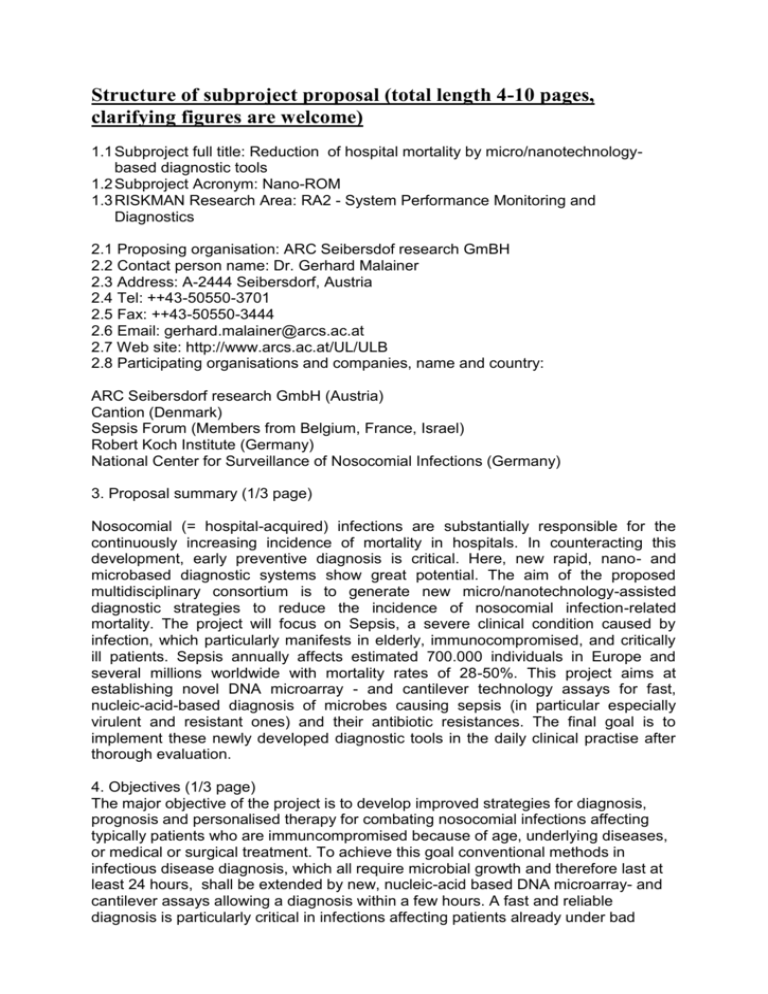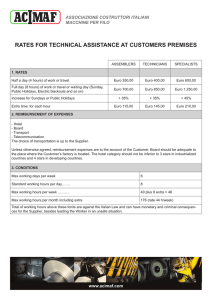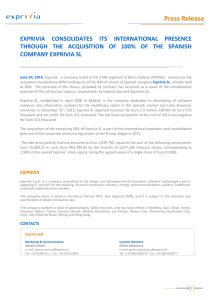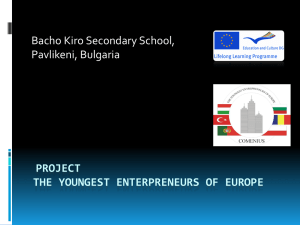Reduction of hospital mortality by micro/nanotechnology
advertisement

Structure of subproject proposal (total length 4-10 pages, clarifying figures are welcome) 1.1 Subproject full title: Reduction of hospital mortality by micro/nanotechnologybased diagnostic tools 1.2 Subproject Acronym: Nano-ROM 1.3 RISKMAN Research Area: RA2 - System Performance Monitoring and Diagnostics 2.1 Proposing organisation: ARC Seibersdof research GmBH 2.2 Contact person name: Dr. Gerhard Malainer 2.3 Address: A-2444 Seibersdorf, Austria 2.4 Tel: ++43-50550-3701 2.5 Fax: ++43-50550-3444 2.6 Email: gerhard.malainer@arcs.ac.at 2.7 Web site: http://www.arcs.ac.at/UL/ULB 2.8 Participating organisations and companies, name and country: ARC Seibersdorf research GmbH (Austria) Cantion (Denmark) Sepsis Forum (Members from Belgium, France, Israel) Robert Koch Institute (Germany) National Center for Surveillance of Nosocomial Infections (Germany) 3. Proposal summary (1/3 page) Nosocomial (= hospital-acquired) infections are substantially responsible for the continuously increasing incidence of mortality in hospitals. In counteracting this development, early preventive diagnosis is critical. Here, new rapid, nano- and microbased diagnostic systems show great potential. The aim of the proposed multidisciplinary consortium is to generate new micro/nanotechnology-assisted diagnostic strategies to reduce the incidence of nosocomial infection-related mortality. The project will focus on Sepsis, a severe clinical condition caused by infection, which particularly manifests in elderly, immunocompromised, and critically ill patients. Sepsis annually affects estimated 700.000 individuals in Europe and several millions worldwide with mortality rates of 28-50%. This project aims at establishing novel DNA microarray - and cantilever technology assays for fast, nucleic-acid-based diagnosis of microbes causing sepsis (in particular especially virulent and resistant ones) and their antibiotic resistances. The final goal is to implement these newly developed diagnostic tools in the daily clinical practise after thorough evaluation. 4. Objectives (1/3 page) The major objective of the project is to develop improved strategies for diagnosis, prognosis and personalised therapy for combating nosocomial infections affecting typically patients who are immuncompromised because of age, underlying diseases, or medical or surgical treatment. To achieve this goal conventional methods in infectious disease diagnosis, which all require microbial growth and therefore last at least 24 hours, shall be extended by new, nucleic-acid based DNA microarray- and cantilever assays allowing a diagnosis within a few hours. A fast and reliable diagnosis is particularly critical in infections affecting patients already under bad health conditions and in such cases can decide over life or death. Sepsis, as one of these clinical scenarios, will be the focus of this study. Oligonucleotide probes will be designed and evaluated, first for identification of the most relevant bacterial species involved in sepsis, and second for detection of antibiotic resistances these pathogens typically display. These two sets of detection probes will be both applied to two different technical platforms, namely DNA microarrays and cantilever technology. The platforms will be compared in their performance and finally tried to be implemented in the daily clinical practise. 5. Deliverables (new products, new processes and services, radical innovations; prime deliverable is expected to be a breakthrough in applicable knowledge to be transferred to industry and society): A novel fast, reliable, nucleic acid based assay for -in particular highly virulent and resistant- bacterial species and antibiotic resistance detection in sepsis taking advantage of nanotechnology tools such as DNA microarrays and cantilevers. In more detail: Specifity-confirmed oligonucleotide probes which allow the identification and differentiation of all sepsis-relevant infectious bacterial species. Oligonucleotide probes for detection of antibiotic resistance genes found typically in the focused sepsis-relevant bacteria. Oligonucleotide microarray for pathogen identification (BactID-chip) Cantilever-based assay for pathogen identification (BactID-Cant) using the same probe set as for the BactID microarray Oligonucleotide microarray assay for antibiotic resistance detection (ABR-chip) Cantilever-based assay for antibiotic resistance detection (ABR-Cant) using the ABR-chip probe set 6. Justification and potential impact (economic impact, direct and indirect economic benefits, European dimension, training and education, conformity with EC societal objectives: quality of life, health, safety, working conditions, employment, and environment) With the great and prolonged morbidity associated with sepsis and the intensive care required, the healthcare expenditures for treating patients with sepsis in Europe and elsewhere in the world are profound. Despite enormous investment in intensive care, sepsis is still associated with mortality rates ranging from 28% to 50%. Due to the lack of fast diagnostic assays medical doctors face the problem to be forced to use broad spetrum antibiotics instead of specifically microbe-targeted drugs which leads to a further increase of antibiotic resistant bacterial strains. As a consequence, the development of new drugs becomes more and more difficult and expensive increasing health expenditures further. The novel diagnostic tools developed in this project should not only reduce mortality rates associated with nosocomial infections but also inhibit a further increase in antibiotic resistance since they allow a more specific antibiotic therapy. . 7. Description of the work (technological approaches and methods, work tasks, their description, deliverables and work effort in person months) marked according to the following components (RTD = Research, technological development and innovationrelated activities, DEM = Demonstration activities, TRA = Training) WP1: Probe design Technical approach / methods: Use of appropiate softwares - ARB suite software for designing specific probes within the 16 S rRNA genes of sepsis-relevant bacterial species - Software developed by iSenseIt for designing probes and multiplex PCR primers for detection of antibiotic resistance genes Work effort in person months : 4 (=RTD) Partners involved: ARC Seibersdorf research GmbH WP2: Working protocol for DNA microarray assays (BactID-chip + ABR-chip) Technical approach / methods: - Evaluation and comparison of DNA isolation methods - Comparison of different target labelling methods - Probe specifity testing Work effort in person months : 44 (RTD 42 TRA 2) Partners involved: ARC Seibersdorf research GmbH WP3: Working protocol for cantilever assays (BactID-Cant + ABR-Cant) Technical approach / methods: - Tests on probe to substrate coupling , on target to cantilever tip coupling respectively - Probe specifity testing Work effort in person months : 15 (RTD 13 , TRA 2) Partners involved: Cantion WP4: Evaluation and clincial implementation of developed assays Technical approach / methods: - Tests on specifity and reliabilty of all kinds of developed assays (BactID-chip, BactID-Cant, ABRchip and ABR-Cant) using reference bacterial strains and sepsis patient samples (blood , blood cultures) - Conventional diagnostic tests on pathogen identification and antibiotic resistance to evaluate data from the newly developed diagnostic tools - Training activities - Implementation of assays in selected diagnostic labs Work effort in person months : ARCS 20 (16RTD, 4DEM), Cantion 15 (12RTD, 3DEM), Clinics 10 (8RTD, 2 TRA) Partners involved: ARC Seibersdorf, Cantion, Clinical partners (Sepsis Forum, RKI, National center for surveillance of nosocomial infections) 8. Partners involved, partner profiles (business idea, size, competence) and the role of each partner Partner Chief scientist Business idea Competence Role in proj ARC Seibersdorf Christa Nöhammer Austrian center for cDNA and Probe desig research GmbH, Biotechnology unit applied research (Seiberdorf, Austria) Cantion (Lyngby, Denmark) Carsten Faltum (CEO) Jean L. Vincent, (International society) (Erasmus Hospital, Belgium) Jean Carlet (Hospital St. Joseph, France) Charles Sprung (Hadassah Hebrew University, Jerusalem) Robert Koch Institute Prof. Witte (Head of Staphylo(RKI, ) coccus reference Wernigerode, center) Germany National Center for Prof. Rüden Sepsis Forum Surveillance of Nosocomial Infections SME Society RKI = German reference center for microbiologyrelated aspects Surveillance of Nosocomial Infections oligonucleotide Developmen microarrays, , probe BactID- and design, slide surface microarrays chemistry Cantion designs, Developmen develops and BactID- and manufactures cantilever as advanced biochips for label free detection of molecules (cantilever technology) Specific interest in Supply with sepsis, collections of strains and sepsis-relevant patient samp pathogens Among others they all have a Staphylococcus strain collection Access to nosocomial infection causing microbes Berlin, Germany 9. Resources for total subproject and for each partner (resources needed: personnel, equipment etc; costs, work effort in person months) ARCS: Cantion: Clinical Partners: 68 person months = 455.600 Euro (calculated with 50 Euro/hr) Material 75.000 Euro 30person months = 201.000 Euro Material 50.000 Euro 10 person months = 67.000 Euro Material 20.000 Euro Total subproject : 868.600 Euro (total costs for person months: 723.600 Euro; total material costs: 145.000 Euro) 10. Duration (starting date, duration in months) WP1 WP2 WP3 WP4 starting date month 0 month 1 month 3 month 21 duration in months 4 months 20 months 12 months 16 months Supply with strains Supply with strains Total duration of the project: 36 months 11. Financial plan First year: 247.900 Euro (person months), 45.000 Euro (material) Second year: 201.000 Euro (person months), 40.000 Euro (material) Third year: 274.700 Euro (person months), 60.000 Euro (material) Total: 723.600 euro (person months), 145.000 Euro (material) 12. Other issues (e.g. ethical, gender, EC policy related issues) The project will be performed in accordance with the ethical principles in widely recognised international texts or codes of practise. All patient samples, collected for WP4, will be coded and identifed only by the code. One of the basic criteria defined by the Eurpoean Commission for Research activities to be funded in the 6th frame program is the focus on nanotechnology and health. This project will cover both aspects applying nanotechnology to develop new tools in infectious disease diagnosis to reduce nosocomial infection-related mortality in hospitals. The creation of a consortium with complementary expertises (DNA microarrays, Cantilever technology, clinicians) will enable a multidisciplinary approach to realize the focused task.







